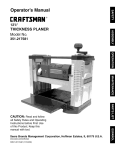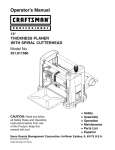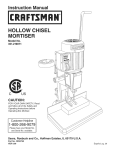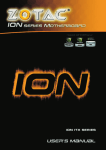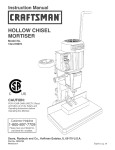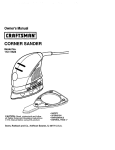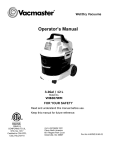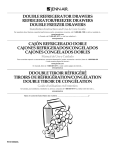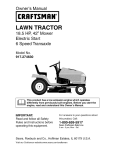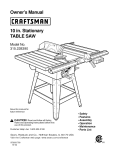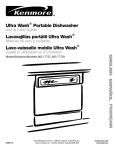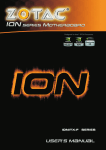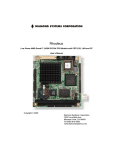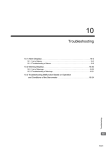Download Craftsman 351.219061 Operator`s manual
Transcript
Operator's Manual CRRFTSMI:IN _ HOLLOW CHISEL MORTISER Model No. 351.219061 CAUTION: Read and follow all Safety Rules and Operating Instructions before First Use of this Product. Sears, Roebuck and Co., Hoffman www.sears.com/craftsman 15140.03 Draft (08/30/02) Estates, IL 60179 U.S.A. PREPARE Warranty.................................. SafetyRules.............................. Unpacking ................................. Assembly ................................ Installation ............................... Operation ................................ Maintenance............................. PartsIllustration andList .................. Espa5ol............................... 2 2-3 3 3-5 5-6 6-8 8-9 10-11 12-19 WORK AREA FOR JOB • Keep work area clean. Cluttered work areas invite accidents. • Do not use power tools in dangerous environments. • Do not use power tools in damp or wet locations. Do not expose power tools to rain. • Work area should be properly lighted. • Proper electrical receptacle should be available for tool. Three prong plug should be plugged directly into properly grounded, three-prong receptacle. • Extension cords should have a grounding prong and the three wires of the extension cord should be of the correct gauge. FULL ONE YEAR WARRANTY If this product fails due to a defect in material or workmanship within one year from the date of purchase, Sears will at its option repair or replace it free of charge. Contact your nearest Sears Service Center (1800-4-MY-HOME) to arrange for product repair, or return this product to place of purchase for replacement. • Keep visitors at a safe distance from work area. • Keep children out of workplace. Make workshop childproof. Use padlocks, master switches or remove switch keys to prevent any unintentional use of power tools. TOOL SHOULD If this product is used for commercial or rental purposes, this warranty will apply for 90 days from the date of purchase. This warranty applies only while this product is used in the United States. This warranty gives you specific legal rights and you may also have other rights which vary from state to state. • Always unplug tool prior to inspection. • Consult manual for specific maintaining and adjusting procedures. • Keep tool lubricated and clean for safest operation. • Remove adjusting tools. Form habit of checking to see that adjusting tools are removed before switching machine on. • Keep all parts in working order. Check to determine that the guard or other parts will operate properly and perform their intended function. • Check for damaged parts. Check for alignment of moving parts, binding, breakage, mounting and any other condition that may affect a tool's operation. • A guard or other part that is damaged should be properly repaired or replaced. Do not perform makeshift repairs. (Use parts list provided to order replacement parts.) Sears, Roebuck and Co., Dept. 817WA, Hoffman Estates, IL 60179 WARNING: For your own safety, read all of the rules and precautions before operating tool. KNOW HOW TO USE TOOL CAUTION: Always follow proper operating procedures as defined in this manual even if you are familiar with use of this or similar tools. Remember that being careless for even a fraction of a second can result in severe personal injury. BE PREPARED • • Use right tool for job. Do not force tool or attachment to do a job for which it was not designed. • Disconnect tool when changing blades. • Avoid accidental start-up. Make sure that the switch is in the OFF position before plugging in. • Do not force tool. It will work most efficiently at the rate for which it was designed. • Keep hands away from moving parts and cutting surfaces. • Never leave tool running unattended. Turn the power off and do not leave tool until it comes to a complete stop. • Do not overreach. Keep proper footing and balance. • Never stand on tool. Serious injury could occur if tool is tipped or if blade is unintentionally contacted. • Know your tool. Learn the tool's operation, application and specific limitations. FOR JOB Wear proper apparel. Do not wear loose clothing, gloves, neckties, rings, bracelets or other jewelry which may get caught in moving parts of machine. • Wear protective hair covering to contain long hair. • Wear safety shoes with non-slip soles. • Wear safety glasses complying with United States ANSI Z87.1. Everyday glasses have only impact resistant lenses. They are NOT safety glasses. • Wear face mask or dust mask if operation is dusty. • Be alert and think clearly. Never operate power tools when tired, intoxicated or when taking medications that cause drowsiness. BE MAINTAINED © Sears, Roebuck and Co, 2 • Use recommended accessories (refer to page 11). Use of improper accessories may cause risk of injury to persons. • Handle workpiece correctly. Protect hands from possible injury. • Refer to Figures 2 - 11. INSTALLING Turn machine off if it jams. THE ELEVATION HANDLE • CAUTION: Think safety! Safety is a combination of operator common sense and alertness at all times when tool is being used. Position the handle with coupling on to the shaft coupling so that the teeth on the couplings mesh properly. • Different teeth-mesh combinations provide different leverage. WARNING: Do not attempt to operate tool until it is completely assembled according to the instructions. • • Position the handle for the desired leverage. Secure handle to shaft coupling using spring and shoulder screw. • Use a 12mm open end or an adjustable wrench to tighten the handle: there are two flats ground on the handle shaft, near the threads. Refer to Figure 1 below. Check for shipping damage. If damage has occurred, a claim must be filed with carrier. Check for completeness. Immediately report missing parts to dealer. The hollow chisel mortiser is shipped complete in one carton. Additional parts which need to be fastened to mortising machine should be located and accounted for before assembling. A Mortising Machine B Fence C D E F Cylinder Handle with Coupling Table Holder G H Chuck Key Handle I J K L M N Adaptor Spring Shoulder Screw Rod Hold-down Wrench Figure 2 - Install Handle INSTALLING THE HYDRAULIC CYLINDER • Determine top from bottom of hydraulic cylinder. The large diameter section goes on the top. • Snap the bottom fitting on its post. 3/8"Mortising Chisel and Bit Set (not shown) Hardware Bag (not shown): 8-1.25 x 8mm Set Screw(2) 6-1.0 x 35mm Socket Flat Head Screw (2) T-nuts (2) Figure 3 - Install Cylinder Bottom • Use the handle to raise the head in order to snap the top fitting on its shaped post. E Figure 4 - Install Cylinder Top • Figure 1 - Unpacking 3 When both ends are snapped in place, check security with a slight tug. H • INSTALLING HOLDER Check the movement of the head, and its return, using the handle. INSTALLING THE TOOL AND CHISEL Slide the tool and chisel holder into the vertical slots towards the back of the mortiser shaft. THE TABLE Place the two flat head screws in the top side of the table, and attach the T-nuts loosely underneath. Figure 8 - Install Chisel Holder INSTALLING BIT AND CHISEL Figure 5 - Attach T-Nuts Bit and chisel come boxed together, with the bit inside the chisel. • Insert the nuts into the slots in the base of the mortiser. Always make sure the mortiser is disconnected from its power source before starting to install the set. Tighten the screws firmly, but not too tight. • Always place the chip escape slot in the chisel shaft to one side, right or left, never to front or rear. Handle chisels with care: they are exceptionally sharp. A small block of wood is a help to hold the chisel in place while the procedure goes on. • Open the chuck access doors. • Open the chuck as far as needed: check by removing the chisel from its drill, and using the drill shank to size the chuck opening. Figure 6 - Install Table INSTALLING HOLD-DOWN • THE FENCE AND Locate the fence handle, rod and handle. Slide the fence shaft into the hole in the column. Figure 9 - Chuck Access Screw the handle into the hole on the outside of the column designed to hold the fence shank, and tighten firmly. Loosen the front set screw on the mortiser, and slide the chisel as far up into the head as it will go. Now, lower the chisel about W' and tighten the set screw. This clearance is essential. The bit cutting lips and the points of the chisel must have the correct clearance; this distance provides that clearance. Slip the rod into the hole on the fence. Turn the shaft so its flat side faces the threaded hole in the fence. Figure 7 - Install Hold-down • Insert the set screw and secure rod to fence. • Figure 10 - Chisel Bushing Slip the hold down on to the rod. Insert set screw and secure hold-down to rod. 4 • • POWER Push the bit as far up through the chisel as it will go into the open chuck. Lock the bit in the chuck using the chuck key. The bit point should be very sharp: use the block of wood used to insert the bit as a pusher. WARNING: The motor is designed for operation on the voltage and frequency specified. Normal loads will be handled safely on voltages not more than 10% above or below specified voltage. Running the unit on voltages which are not within range may cause overheating and motor burnout. Heavy loads require that voltage at motor terminals be no less than the voltage specified on nameplate. NOTE: Hollow chisel mortiser is supplied with an adaptor to accept short shank drill bits. To install adaptor: • Make sure the morfiser is turned off and disconnected from the power source. . Open the access windows from both sides of the mortiser head. • Hold the motor shaft by the flats through the access window. Use the wrench supplied. • Through the other access window, insert chuck key into the hole on the outside of the chuck. • Turn the chuck key counterclockwise the motor shaft. • Loosen and remove chuck. • Install adaptor onto motor shaft using the threaded hole. Tighten adaptor. • Do not connect hollow chisel mortiser to the power source until all assembly steps have been completed. Loosen the front set screw and move chisel up to head. The proper clearance between bit and chisel is now set. • SOURCE Power supply to the motor is controlled by a rocker switch. Removing the key from rocker switch will lock the unit and prevent unauthorized use. GROUNDING INSTRUCTIONS WARNING: Improper connection of equipment grounding conductor can result in the risk of electrical shock. Equipment should be grounded while in use to protect operator from electrical shock. while holding . Check with a qualified electrician if you do not understand grounding instructions or if you are in doubt as to whether the tool is properly grounded. . This tool is equipped with an approved cord rated at 150V and a 3-prong grounding type plug (See Figure 12) for your protection against shock hazards. Install chuck onto adaptor using the threaded hole. Tighten chuck. o Grounding plug should be plugged directly into a properly installed and grounded 3-prong groundingtype receptacle, as shown (See Figure 12). Grounded Outlet Grounding Prong 3-Prong Plug Properly Figure 12 - 3-Prong Receptacle Figure 11 - Tighten Chuck ° The hollow chisel mortiser weighs approximately 50 Ibs. when completely assembled. The hollow chisel mortiser must be installed in a place with ample lighting and correct power supply. To install hollow chisel mortiser: . . . . __ Do not remove or alter grounding prong in any manner. In the event of a malfunction or breakdown, grounding provides a path of least resistance for electrical shock. WARNING: Do not permit fingers to touch the terminals of plug when installing or removing from outlet. Make sure there is plenty of room for moving the workpiece through the entire cut. There must be enough room that neither the operators nor the bystanders will have to stand in line with the wood while using the tool. Use this tool only after fastening it to the bench: the long handle gives needed leverage for mortising, but also pulls the machine forward and over. Insert two lag 5/16"x 2" screws (not supplied), with flat washers, through the holes in the base, and drive them into the benchtop, after drilling pilot holes. If the mortiser is to be left portable, attach it to a 3/4" x 13" wide x 16" long plywood base (not supplied) that can be clamped or bolted to the benchtop. 5 • Plug must be plugged into matching outlet that is properly installed and grounded in accordance with all local codes and ordinances. Do not modify plug provided. If it will not fit in outlet, have proper outlet installed by a qualified electrician. • Inspect tool cords periodically, and if damaged, have repaired by an authorized service facility. • Green (or green grounding wire. tric cord or plug green (or green • A 2-prong wall receptacle must be replaced with a properly grounded 3-prong receptacle installed in accordance with National Electric Code and local codes and ordinances. and yellow) conductor in cord is the If repair or replacement of the elecis necessary, do not connect the and yellow) wire to a live terminal. Hertz .................................... WARNING: Any receptacle replacement should be performed by a qualified electrician. Phase ................................ RPM .................................. A temporary 3-prong to 2-prong grounding adapter (See Figure 13) is available for connecting plugs to a two pole outlet if it is properly grounded. Make Sure This Grounding Lug _ Is Connected 3-Prong Plug ELECTRICAL 60 Single 1725 CONNECTIONS WARNING: Make sure unit is turned off and disconnected from power source before inspecting any wiring. To A Known Ground ON-OFF SWITCH The operating positions of the ON-OFF switch are located on the front of your mortiser. Push the switch up to turn mortiser On and push down to turn the unit Off. 2-Prong Receptacle Figure 13 - 2-Prong Receptacle with Adapter • The switch has a removable key that allows the unit to be locked in the OFF position. Do not use a 3-prong to 2-prong grounding adapter unless permitted by local and national codes and ordinances. (A 3-prong to 2-prong grounding adapter is not permitted in Canada.) To activate locking mechanism: Push the switch to OFF position. Pull switch key. Where a 3-prong to 2-prong grounding adapter is permitted, the rigid green tab or terminal on the side of the adapter must be securely connected to a permanent electrical ground such as a properly grounded water pipe, a properly grounded outlet box or a properly grounded wire system. To deactivate locking mechanism: insert and press switch key in the slot on switch. Many cover plate screws, water pipes and outlet boxes are not properly grounded. To ensure proper ground, grounding means must be tested by a qualified electrician. EXTENSION • • CORDS Figure 14 - On-Off Switch The use of any extension cord will cause some drop in voltage and loss of power. Wires of the extension cord must be of sufficient size WARNING: Be sure the switch is in OFF position and the cord is unplugged from the power source before removing switch key. to carry the current and maintain adequate voltage. • Use the table to determine the minimum wire size (A.W.G.) extension cord. • The motor is assembled with an approved three conductor cord to be used on 120 volts as indicated. The power supply to the motor is controlled by a double pole locking rocker switch. Use only 3-wire extension cords having 3-prong grounding type plugs and 3-pole receptacles which accept the tool plug. Remove the key to prevent unauthorized use. The power lines are inserted directly onto the switch. The green ground line must remain securely fastened to the frame to properly protect against electrical shock. If the extension cord is worn, cut or damaged in any way, replace it immediately. EXTENSION CORD LENGTH Wire Size A.W.G. Up to 50 ft ................................ 50-100 ft .................................. 16 14 DESCRIPTION NOTE: Using extension cords over 100 ft. long is not recommended. The Craftsman hollow chisel mortiser is a heaw duty, portable, machine designed to produce mortises up to _/2"wide in hardwoods and 3/4"wide in softwoods. Slow MOTOR feeds and patience allow the user to create 3/4"wide mortises in most hardwoods. The Craftsman mortiser is Mortising machine is supplied with a 1/_HP (max developed) motor. powered by a 120 volt, 4.0 amps, 60 Hz electric motor. The mortiser uses hollow chisel mortising tools. While the Craftsman mortiser is designed for portability, it should never be used without secure fastening to a solid bench or other surface to prevent tipping. The 120 Volt AC universal motor has the following specifications: Horsepower (Maximum Developed) .............. 1/_ Voltage ................................. 120 Amperes 4.0 ................................ 6 SPECIFICATIONS Chisel capacity ........................ 1/4"to 3/4" Turn switch off and disconnect power whenever mortiser is not in use. Maximum height of work under head, with W' chisel and bit in place; normal base position (not reversed): ................. Vertical Stroke of head ..................... 4W' 45/8" Fence to center of chisel maximum distance: ..... 3W' Chuck capacity ............................ Weight ................................ OPERATION SAFETY on medications that affect your emotional or physical stability. Keep mortiser maintained. Follow maintenance instructions (see page 9). OPERATING 3/8" THE HEAD The head is moved with the handle. The lever is long enough to give a great deal of leverage: make sure the machine is clamped or bolted to the bench or other stable surface. 67 Ibs RULES WARNING: Operation of any power tool can result in foreign objects being thrown into eyes which can result in severe eye damage. Always wear safety goggles complying with United States ANSi Z87.1 (shown on package) before commencing power tool operation. Use the depth stop rod to adjust the depth of the mortise. The rod has has a set screw to hold it at the depth needed. The flat side on the depth stop rod gives good surface for the set screw. Loosen the set screw. WARNING: For your own safety, read all of the instructions and safety precautions before operating tool. • Know general power tool safety. Make sure all precautions are understood (see pages 2, 3, 5 and 6). • Whenever adjusting or replacing any parts on morriser, turn switch off and remove plug from power source. • Make sure all moving parts are free from interference. • Always wear eye protection or face shield. Figure 15- Do not plug in mortiser unless switch is in OFF position. After turning switch on, allow morfiser to come to full speed before operating. Move the chisel down to the desired depth (mark the depth on a piece of scrap wood and bring the chisel down to that mark). Keep hands clear of all moving parts. Hold the chisel at that mark, and slide the depth stop rod down. Tighten the set screw. Use the mortiser only for mortising hard and soft woods. • Adjust Depth Stop • Make sure workpieces are free of foreign objects such as nails, screws, staples, etc. ADJUSTING • Secure workpiece under holddown to prevent it from lifting. • Support workpiece against fence to prevent it from spinning. • Make sure the machine is securely mounted on its bench, or on a plywood mounting plate that may be clamped to a bench or other work surface. Keep lightly lubricated as directed. Make sure all included covers are in place and secured before operating the mortiser. DOWN ADJUSTMENT The hold-down keeps the workpiece from lifting as the chisel and bit set is backed out of the mortise. Adjust the hold-down so it just touches the top of the workpiece, while allowing the workpiece to slide right and left without hindrance. Disconnect power when changing bits and chisels. • The fence slides in and out after the knob is loosened HOLD Make sure drills and chisels are sharp. Always keep hands and fingers clear of the descending head and the turning bit. THE FENCE Again use scrap stock of the correct size to align the fence. Always check alignments before working in good stock. Make sure drill bit chisel is properly secured. • Operate without power to check, and re-set if needed. Clear blockages only after disconnecting power. • Do not leave the morfiser running when it is unattended. • Keep children away from the mortiser at all times. • Do not operate the mortiser when you are tired, ill or Figure 16 - Adjust Hold Down 7 Placing the hold-down on its shaft upside down gives another %" clearance for thicker stock, but the hold-down set screw does not then hit the flat on the hold-down shaft, so the hold-down may not be as secure as needed unless special care is taken in tightening the set screw. • Remove the handle. • Lie the machine on its back and remove both hex nuts, washers and socket head bolts. • Reverse the base and reinstall the socket head bolts, washers and hex nuts. • Stand the mortiser upright, and clamp the base to the bench or table. Make sure it is very securely clamped as the entire weight of the mortising head is now off the bench. • Reinstall the handle. Figure 17 - Adjust Chisel CHISEL ADJUSTMENT The Chisel must be adjusted parallel to the workpiece's side for standard mortising. • • • • Place a piece of stock of the correct size in the holddown, against the fence. Loosen the set screw on the chisel shank. • Turn the chisel until its back surface is flat to the workpiece. Install the fence and hold-down, if those have been removed. • Follow earlier procedures for alignment and cutting. Figure 18- Reverse Setup Tighten the set screw. MORTISING OPERATION • Select a sharp chisel of the size needed for the mortise, and install it as described earlier in this manual. • • Next, set the depth. To move the work to the left to continue the mortise WARNING: Turn the switch to OFF position and unplug mortiser from power source before proceeding to do maintenance work. GENERAL MAINTENANCE length, set the chisel opening to the left. To move work to the right, set the chisel opening to the right. This helps keep chips form obscuring the work area. Mortiser will operate best if it is kept in good operating condition. Keep unit adjusted as described in "Operation." • Adjust the hold-down securely. • • Keep a steady, firm hand on the lever and feed the bit and chisel into the workpiece as fast as the workpiece accepts the feed without the mortiser motor stalling. Too slow a speed may burn the bit tip. Do not allow gum and pitch to accumulate on the tables, fence, blades and blade guard. • Apply a thin coat of paste type wax to the tables and the fence so that the wood slides easily while feeding. • Do not allow chips to accumulate on the underside of the Mortiser. • • Light smoke is a normal part of the operation with some woods, as resins burn off, and chip friction creates heat. A blued chisel is not a sign of dullness, but of chip friction heat and resin build-up. The chisel is too dull when a lot of force is needed to ADJUSTING THE HEAD-TO-COLUMN FIT A dovetail gib fits into a dovetail way on the mortiser shaft. On the right side-facing the machine from its operating position-there are two allen head set screws with nuts. Inside the dovetail gib, those screws bear on a steel plate that rides on the dovetail way. This assembly provides an adjustment for wear that comes with use. continue working easily. Tip: For through mortises, use a sacrificial backer board to prevent chip out and table damage. MORTISING INTO THE ENDS OF LONG (OR SIDES OF THICK) PIECES Often, mortises are needed in taller pieces than can fit under the hold-down when the base is used. In such cases, rotating the mortiser on its base can be done. • Removed the tool holder and tools. 8 • Loosen the lock nuts. • Adjust upper and lower Allen screws until the gib moves easily, but not sloppily, on the way. The fit should be snug, but the movement must also be easy. No side to side slop should be evident. Figure 19 - Adjust Gib + Tighten the lock nuts and check the movement again. 9 Model 351.219061 Figure 20 - Replacement Parts Illustration 49 for Mortising 51 17 14 37 41 53 .J 45 44 29 28 27 10 Machine KEY NO. PART NO. DESCRiPTiON 15850.00 17300.00 00483.00 Tool Holder Column 8-1.25 x 25mm Socket Head Bolt 1 1 3 4 5 6 7 8 9 10 11 12 13 14 15 16 17 15888.00 08066.00 15889.00 17301.00 00958.00 15854.00 15855.00 17302.00 15886.00 STD852008 15887.00 15857.00 17303.00 04417.00 Capacitor Switch Switch Box Handle 8-1.25 x 8mm Set Screw Hold-Down Rod Fence 1 1 1 1 2 1 1 1 Depth Stop Rod 8mm Lock Washer* Motor Trout Base 4-0.7 x 6mm Socket Pan Head Screw 1 3 1 2 1 2 18 19 15884.00 15860.00 2 2 2O 21 17304.00 15862.00 6 x 28mm Spring Pin 6-1.0 x 35mm Socket Flat Head Screw Table 10 x 35ram Socket Head Shoulder Screw 22 23 24 15863.00 17402.00 15865.00 15866.01 15070.00 17403.00 15868.00 15869.00 Spring Handle Coupling Handle 1 1 1 Grip Adaptor Shaft Coupling Shaft Collar 1 1 1 1 1 1 2 3 25 26 27 28 29 KEY NO. QTY. PART NO. DESCRiPTiON 32 33 07322.00 15870.00 01210.00 16846.00 34 01775.00 35 36 37 15871.00 15872.00 06701.00 38 39 4O 41 42 43 44 45 46 47 16847.00 15874.01 15875.01 01474.00 15877.01 15878.00 05110.00 STD840610 08560.00 01505.00 5x5x12mmKey Gear 5-0.8 x 5mm Set Screw 8-1.25 x 20mm Brass Flat Point Set Screw 6-1.0 x 25mm Socket Head Bolt Cover Plate 5-0.8 x 8mm Socket Pan Head Screw Knob 48 49 50 51 52 53 54 55 A A A 15879.00 01601.00 16426.00 15882.00 15883.00 00935.00 15885.00 18967.00 26413 26417 15140.03 30 31 1 1 * Standard hardware item available locally. A Not Shown Recommended 11 QTY. 1 1 1 1 4 2 2 6 2 Chuck Key Chuck with Key 5mm Serrated Washer Head 1 1 1 1 Bushing 6-1.0 x 20mm Set Screw 6-1.0mm Hex Nut* 8-1.25 x 16ram Set Screw 6-1.0 x 12mm Socket Head Bolt Rack Strain Relief Plate Ball Head Screw 1 2 4 1 2 Hydraulic Cylinder Line Cord Gib Wrench 1 1 1 1 Mortising Bit 3/8" Mortising Chisel 8/_,, Owner's Manual 1 1 1 1 1 2 2 Accessories A Mortising Bit 1/4" 9-26411 A Mortising Bit 8/1U' 9-26412 A Mortising Bit W' 9-26414 A Mortising Chisel 1/4" 9-26415 A Mortising Chisel 8/16" 9-26416 A Mortising Chiset 1/t" 9-26418 IVIORTAJADORA DE FORIVION HUECO • Use zapatos • Use galas de seguridad que cumplan con ANSI Z87.1 de los Estados Unidos. Los espejuelos para uso diario s61o tienen lentes resistentes al impacto. NO son galas de seguridad. Modelo No. • Use una mascara para la cara o contra operaci6n es polvorosa. 351.219061 • PRECAUCION: Lea y siga todas las Reglas de Seguridad y las Instrucciones de Operaci6n antes de usar este producto por primera vez. Est6 alerta y piense claramente. Nunca opere las herramientas mecanicas cuando est6 cansado, intoxicado o cuando est6 tomando medicamentos que producen somnolencia. PREPARE Ingles ....................................... Ilustraci6n Garantia Reglas y Lista 10-11 ...................................... de Seguridad Desempaque Montaje 12 .......................... ...................................... 15 .................................. 15-17 Operaci6n .................................. 17-18 Mantenimiento ............................... GARANTIA COMPLETA Si fallara este producto por causa 18-19 No use herramientas mecanicas en entornos • No use herramientas dos. No las exponga mecanicas a la Iluvia. en lugares • El Area de trabajo correcta. • Tiene que haber un receptaculo electrico correcto disponible para la herramienta. El enchufe de tres puntas se debe enchufar directamente en un receptaculo para tres puntas, conectado a tierra correctamente. • Los cordones de extensi6n deben tener una punta para la conexi6n a tierra y los tres cables del cord6n de extensi6n tienen que ser del calibre correcto. • Mantenga trabajo. • Mantenga a los niSos fuera del lugar de trabajo. Haga que el taller sea a prueba de niSos. Use candados, interruptores principales o remueva las Ilaves de los interruptores para evitar el uso no intencional de las herramientas mecanicas. DE UN AI_IO de defectos alas de- peligrosos. hQmedos o moja- tiene que contar con una iluminaci6n visitas a una distancia ES NECESARIO en el material PARA LA TAREA • 15 Instalaci6n DE TRABAJO el polvo si la Mantenga el Area de trabajo limpia. Las Areas de trabajo sordenadas atraen accidentes. 12-13 .................................. EL AREA con suelas antideslizantes. • 2-9 de Partes ..................... de seguridad MANTENER segura del Area de LAS HERRAMIENTAS en la mano de obra en un lapso de un aSo a partir de la • Siempre fecha de compra, Sears Io reparara o reemplazar& a su elecci6n, sin costo adicional. Solicite al Centro de servicio Sears (1-800-MY-HOME) mas cercano la reparaci6n del • Consulte el manual para ver los procedimientos de mantenimiento y ajuste. • Mantenga operaci6n • Remueva las herramientas de ajuste. Adquiera el habito de revisar para verificar si se han removido las herramientas de ajuste antes de encender la maquina. • Mantenga todas las partes listas para trabajar. Inspeccione la herramienta para verificar si los dispositivos de protecci6n o si las demas partes pueden operar correctamente y desempeSar la funci6n para la que han sido diseSadas. • Revise para verificar si hay partes daSadas. Revise el alineamiento de las partes movibles, verifique si su movimiento se halla restringido, si estan rotas, si se sobremontan o si existe alguna otra condici6n que pueda afectar la operaci6n de la herramienta. • Es necesario cambiar o reparar correctamente un mecanismo de protecci6n u otra parte que est6 daSada. No haga reparaciones provisorias. (Use la lista de partes que se ofrece para encargar las partes de repuesto.) producto o devuelvalo al establecimiento donde Io adquiri6. Si este producto se usa para fines comerciales o de alquiler, esta garantia es valida por 90 dias a partir de la fecha de compra. Esta garantia aplica L_nicamente cuando en los Estados Unidos. el producto se utiliza Esta garantia le otorga derechos legales especMcos y tambien puede usted tener otros derechos que varien de estado a estado. Sears, Roebuck IL 60179 and Co., Dept. 817WA, Hoffman ADVERTENClA: Para su propia seguridad, y las precauciones antes de operar la herramienta. PRECAUClON: Siempre lea todas las reglas siga los procedimientos correctos, tal como se definen en este manual, familiarizado con esta o con otras herramientas • Use la ropa adecuada. No use ropa suelta, Use una cubierta tener, el cabello de protecci6n para el cabello, lubricada especificos y limpia para Iograr una Use la herramienta correcta para el trabajo. No fuerce la herramienta ni el accesorio para hacer un trabajo para el que no han sido diseSados. • Desconecte • Evite que arranque est6 en la posici6n corbatas, engancharse la herramienta mas segura. antes de inspeccionarla. • de segundo, guantes, la herramienta APRENDA COMO USAR LA HERRAMIENTA PARA EL TRABAJO anillos, pulseras, ni otras joyas que puedan partes m6viles de la maquina. • de operaci6n aun cuando est6 parecidas. Re- cuerde que, si se descuida por siquiera una fracci6n puede sufrir lesiones personales graves. PREPARESE Estates, desenchufe alas • para con- • 12 cuando cambie las cuchillas. por accidente. AsegQrese que el interruptor OFF (apagado) antes de enchufarla. No fuerce la herramienta. velocidad largo. la herramienta Funciona mas eficientemente a la para la que rue diseSada. Mantenga las manos alejadas superficies cortadoras. de las partes movibles y de las • Nunca deje la herramienta desatendida nando. Apague la energia electrica hasta que pare completamente. • No trate de alcanzar y el equilibrio • cuando m_.s de Io posible. Mantenga con la cuchilla pot accidente. Conozca su herramienta. Aprenda y sus limitaciones especificas. su operaci6n, • Use los accesorios (refierase recomendados Si se usan los accesorios incorrectos cotter el riesgo de lesionarse. Maneje la pieza de trabajo manos contra posibles a la pb.gina 13). las personas correctamente. pueden Protejase las Apague la mb,quina si se atasca. La cuchilla se atasca si se introduce dentro de la pieza de trabajo a mucha profundidad. atascada Figura 1 - Desempaque en el trabajo.) Siempre mantenga la protecci6n del mecanismo de accionamiento, del portacuchillas y de la cuchilla en su lugar, yen • su aplicaci6n lesiones. (La fuerza del motor la mantiene • E Nunca se pare sobre la herramienta. Se pueden producir lesiones graves si la herramienta se inclina o si usted entra en contacto • la posici6n correctos. • • este funcio- y no deje la herramienta condiciones para operar correctamente. Alimente el trabajo dentro de la cuchilla en contra de la direcci6n de rotaci6n. PRECAUCION: iPiense en la seguridad! o del portacuchillas La seguridad Consulte INSTALACION DE LA MANIVELA DE ELEVACION es una combinaci6n del sentido comQn del operador y de estar alerta en todo momento cuando se est,. usando la herramienta. ADVERTENOIA: No trate de operar la herramienta este completamente V6ase montada • Coloque la manivela con acoplamiento en el acoplamiento del eje de manera que los dientes en los acoplamientos engranen adecuadamente • Diferentes combinaciones nan diferentes potencias • Coloque • Asegure hasta que segQn las instrucciones. resorte la figura 1 a continuaci6n. • Verifique que no hayan ocurrido daSos durante el envio. Si hay daSos, se deber_, presentar un reclamo a la compaSia de transporte. Verifique que est6 completa. tribuidor si faltan partes. La mortajadora de form6n las figuras 2-11. Avise inmediatamente hueco se envia completa al dis- la manivela la manivela y el tornillo de engranes para la potencia en el acoplamiento de dientes proporcio deseada del eje usando el de tope Use una Ilave de extremo abierto ajustable para apretar la manivela: tificados en el eje de la manivela de 12 mm o una Ilave hay dos puntos pianos rec cerca de las roscas en una caja. Es necesario Iocalizar y tomar en cuenta las partes adicionales que deben asegurarse a la herramienta antes de armarla: A Mortajadora B Reborde C Cilindro D Manivela E Mesa F Sujetador G CuSa del portabroca H Manivela INSTALACION DEL CILINDRO HIDRAULICO I Adaptador • J Resorte Determine cu_l es la parte superior e inferior del cilindro secci6n cuyo di_metro es mayor ira en la parte superior K Tornillo • Enganche L Varilla M Sujetador N Llave con acoplamiento Figura 2 - Instale la manivela de tope %" Juego de Mortajadora Bolso de articulos Tornillo Tornillo de Form6n y Barrena de ferreteria el acoplamiento inferior en su soporte (no se muestra) (no se muestra): de fijaci6n de 8-1.25 x 8 mm (2) de cabeza plana hueca de 6-1.0 x 35 mm (2) Tuercas T (2) Figura 3 - Instale 13 la parte inferior del cilindro La • Use la manivela acoplamiento para elevar el cabezal superior en su soporte a fin de engachar el conformado. Figura 7 - Instale el sujetador Figura 4 - Instale la parte inferior del cilindro • Cuando ambos extremos enganchen en su posici6n, verifique que hayan quedado asegurados d_.ndoles un peque_o tir6n. • Verifique el movimiento manivela. del cabezal, y su retorno, usando Inserte el tornillo • Deslice el sujetador en la varilla. Inserte y asegure el sujetador a la varilla. • de Deslice verticales Figura 5 - Inserte las tuercas • Inserte las tuercas • Apriete la herramienta 8 - Instale el soporte el tornillo de fijaci6n AsegQrese en las ranuras del formbn siempre se envian en una misma de que la mortajadora la fuente de alimentaci6n • del form6n del eje de la mortajadora. DE LA BARRENA Y EL FORMON La barrena y el form6n dentro del form6n. pero no demasiado. y el soporte hacia la parte posterior INSTALACION T en las ranuras de la base de la mortajadora. bien los tornillos, la varilla al reborde. INSTALACION DE LA HERRAMIENTA Y EL SOPORTE DEL FORMON Coloque dos tornillos de cabeza plana en el lado superior la mesa, e inserte debajo las tuercas T sin apretarlas. Figura de fijaci6n y asegure la INSTALACION DE LA MESA • • caja; la barrena este desconectada antes de comenzar a instalar de el juego. Coloque siempre la ranura de escape de virutas en el eje del form6n, ya sea en el lado izquierdo o derecho, pero nunca en la parte frontal o posterior. Maneje los formones con cuidado: los mismos son sumamente afilados. Use un bloque de madera para ayudar a mantener el form6n mientras se Ileva a cabo el procedimiento. • Abra las puertas • Abra el portabroca de acceso al portabroca. tanto como necesite: form6n de su barreno, y usando medir la abertura del portabroca. Figura 6 - Instale la mesa INSTALACION DEL REBORDE Y EL SUJETADOR • Ubique la manivela • Deslice • Atornille Deslice la varilla y la manivela. el eje del reborde en el orificio la manivela columna dise_ado apdete bien. • del reborde, de la columna. en el orificio de la parte exterior para sostener la varilla en el orificio de la el v_.stago del reborde, del reborde. manera que el lado piano quede orientado roscado en el reborde. y Gire el v_.stago de Figura 9 - Acceso al portabroca hacia el orificio 14 en su posici6n revise retirando el v_.stago del barreno el para Afloje el tornillo de fijaci6n deslice el form6n Ahora, descienda anterior en la mortajadora, y una fuente de alimentaci6n de form6n hueco: en el cabezal hacia arriba hasta que tope. el form6n aproximadamente 3 mm y apriete • el tornillo de fijaci6n. Este espacio libre es muy importante. Los rebordes de corte de la barrena y los puntos del form6n debe contar con el espacio libre adecuado; porciona dicho espacio libre. esta distancia adecuada. Para instalar la mortajadora AsegtJrese que haya suficiente espacio para mover la pieza de trabajo a trav6s de todo el corte. Deber_. haber suficiente espacio de manera que ni los operadores ni dem_.s personas tengan que pararse en linea con la madera mientras se est6 usando la herramienta. pro- • • Use esta herramienta el banco: la manivela s61o despues de haberla asegurado en larga brinda la potencia necesaria para mortajar, pero adem_.s tira de la m_.quina hacia delante hacia arriba. y Inserte dos tornillos de fijaci6n con de 5/16"x 2" (no incluidos), arandelas planas, a trav6s de los orificios en la base, y atornillelos en el banco de trabajo, luego de perforar orificios pilotos. • Empuje la barrena a trav6s del form6n hacia arriba hasta barrena de estar bien afilada: use el bloque de madera emple6 para insertar el form6n como refuerzo. Afloje el tornillo de fijaci6n anterior y mueva el form6n arriba en el cabezal. El espacio libre correcto y el form6n se encuentra ahora ajustado. AVlSO: La mortajadora que pueda sujetarse o apernarse al banco de trabajo. FUENTE DE ALIMENTACION que tope en el portabroca abierto. BIoquee la barrena en el portabroca usando la cuba del portabroca. La punta de la • es para uso port_.til, fijela a una base de de 19 mm x 330 mm ancho x 406 mm de largo (no incluidos) Figura 10 - Buje del form6n • Si la mortajadora madera laminada ADVERTENCIA: No conecte la mortajadora de form6n hueco a la fuente de alimentacidn hasta haber cumplido todos los pasos que del ensamblaje. El motor ha sido diseSado para funcionar al voltaje y frecuencia especificados. Las cargas normales se pueden manejar sin ries- hacia entre la barrena de form6n hueco inciuye un adaptador gos dentro de un intervalo del 10% respecto al voltaje especificado. Si se hace funcionar la unidad a un voltaje fuera de este para trabajar con brocas de v&stago corto. Para instalar el adaptador: intervalo, se puede recalentar y quemar el motor. Las cargas pesadas exigen que el voltaje en los terminales del motor no sea • AsegQrese que la mortajadora de la fuente de alimentaci6n. inferior al especificado. • Abra las ventanas este apagada y desconectada • de acceso a ambos lados del cabezal de la interruptor mortajadora. • • culante, Sostenga el eje del motor pot los puntos pianos ventana de acceso. Use la Ilave que se incluye. A trav_s de la ventana portabroca de acceso, inserte en el orificio de la parte • Afloje y retire el portabroca. • Instale roscado. Apriete en el eje del motor usando alas manillas mediante la unidad e impide PARA LA CONEXION A TIERRA a tierra del equipo, se corre el riesgo de un electrochoque. Si no entiende correctamente las instrucciones rosca- Esta herramienta viene equipada el conductor El se usa para prote- de conexi6n a tierra o duda que la herramienta haya quedado efectivamente tierra, consulte un electricista calificado. el orificio un bas- el uso no autorizado. Si no se conecta • el orificio se controla ADVERTENClA: • usando se bloquea del motor Si se extrae la Ilave del interruptor equipo debe estar conectado a tierra mientras ger al operador de un electrochoque. el adapatador. Instale el portabroca en el adaptador do. Apriete el portabroca. basculante. INSTRUCClONES exterior del portabroca. Gire la cuba del portabroca en sentido contrario del reloj a la vez que sostiene el eje del motor. el adaptador a trav_s de la la cuba del • • La fuente de alimentacidn puesta a con un cable especificado para 150 V y un enchufe de 3 espigas para conexi6n a tierra (vea la figura 12) que Io protegen a usted de un electrochoque. • El enchufe de conexi6n mente a un z6calo a tierra deber_, conectarse para 3 clavijas instalado directa- y conectado Enchufe de 3 puntas tierra Tomacorriente puesto a tierra Espiga de __ adecuadamente Figura Figura 11 - Apriete el portabroca 12- Recept_culo debidamente • para 3 puntas a tierra, tal como se muestra No retire ni modifique (vea la figura 12). en forma alguna la clavija de conexi6n a tierra. En caso de un mal funcionamiento o una descompostura, la conexi6n a tierra proporciona una ruta de menor resistenLa mortajadora de form6n hueco pesa aproximadamente cia para la descarga 50 lb. ADVERTENClA: luego de ser ensamblada. La mortajadora de form6n hueco debe instalarse en un lugar que cuente con suficiente iluminaci6n y Io, no permita 15 electrica. AI conectar o desconectar el enchufe por ningtJn motivo que sus dedos toquen del z6calas clavijas. • El enchufe debe conectarse en el tomacorriente LONGITUD correspon- diente que haya sido instalado y conectado a tJerra debidamente, de acuerdo con todos los c6digos y regulaciones Hasta 50 pies locales. No modifique el enchufe que se incluye. Si no cabe en el tomacorrJente, solicite a un electricista profesional que instale un tomacorriente adecuado. • Un z6calo a un terminal para dos clavijas z6calo para tres clavijas debidamente instalado de acuerdo con las Normas Electricas (National ciones locales. ADVERTENCIA: Electric 50-100 pies ...................................... AVlSO: No se recomienda La mortajadora m_.ximo). induye El motor universal 16 14 utilizar cordones de extensi6n Caballaje con un Voltaje conectado a tierra e para Instalaciones un motor de 1/2 HP (desarrollado de CA de 120 voltios tiene las siguientes (m_.ximo desarrollado) ....................... 1/2 Frecuencia 120 ....................................... 4.0 (Hz) ................................... 60 Fase ..................................... calificado al ......................................... Amperaje Code) y los c6digos y regula- S61o un electricista de m_.s especificaciones: con corriente. deber& set reemplazado (segQn la norma A.W.G.) .................................... MOTOR El conductor verde (o verde y amarillo) del cable es para conexi6n a tierra. Si es necesario reparar o reemplazar el cable de alimentaci6n o el enchufe, no conecte el hilo verde (o verde y amarillo) • DE EXTENSION .............. de 30 metros de largo (100 pies). Revise peri6dicamente los cordones de la herramienta, si estb_n da_ados, Ilevelos a un centro de servicio autorizado para que los reparen. • DEL CORDON TamaSo del alambre debe cambiar Monof_.sico RPM .......................................... 1725 los recept_.culos. CONEXIONES Existe un adaptador de conexJ6n a tierra con tres clavijas para un z6calo de dos clavijas (v6ase la figura 13); con 61 podr_, conectar enchufes a un tomacorrientes bipolar siempre encuentre debidamente conectado a tierra. LA_ga__°dre---,._ j,tierra __ \.._"z.. y cuando _ este se INTERRUPTOR DE ON/OFF (ENCENDIDO/APAGADO) Astg_eSeefdadqUae Enchufe de 3 pun_l Las posiciones de operaci6n del interruptor de ON/OFF (encendido/ apagado) est_.n ubicadas en la parte frontal de su mortajadora. una tierra conocida • __ _ Receptaculo • con adaptador jadora • el interruptor hacia arriba y hacia abajo para apagar a menos que este permJtinacionales y locales. (Este no se permiten en CanadA). la morta- el interruptor Empuje ,, Tire de la Ilave del interruptor. • a la posici6n el mecanismo Inserte y empuje bloquear de bloqueo: • Para desactivar Si se permite el uso de un adaptador de 3 a 2 espigas con conexi6n a tJerra, se debe conectar firmemente la lengOeta para encender la unidad. El interruptor tiene una Ilave removible que permite la unidad en la posici6n de OFF (apagado). para enchufe Para activar el mecanismo No utilice este tipo de adaptadores do pot los c6digos y regulaciones tipo de adaptadores Empuje para enchufe de 2 puntas Figura 13 - Recept_culo de 2 espigas ELECTRICAS ADVERTENCIA: Cerci6rese de que la unidad este apagada y desconectada de la fuente de alimentaci6n antes de inspeccionar el cableado. de OFF (apagado). de bloqueo: la Ilave del interruptor en la ranura del interruptor. verde o terminal rigido en un lado del adaptador a una toma de tierra permanente, p. ej., una tuberia de agua puesta a tierra, una caja de tomacorriente de cables puesto a tierra. • Muchos de los tornillos puesta a tierra o un sistema para placas de cubierta, las tuberias para ca_eria y las cajas de distribuci6n no estb_n debidamente conectados a tierra. Para garantizar que la conexi6n a tierra es efectiva, tierra. un electricista calificado debe verificar la toma de CABLES DE EXTENSION • El uso de cualquier tipo de cord6n de extensi6n una caida en el voltaje y una perdida • Los alambres suficiente del cord6n de extensi6n para transportar la corriente Figura 14 - Interruptor de ON-OFF (encendido/apagado) ocasionar_. de potencia. ADVERTENClA: adecuada y mantener el voltaje correcto. El motor se ensambla • Utilice la tabla para determinar el tama_o m[nimo (segOn la norma AWG) del cord6n de extensi6n. del alambre • UtilJce OnJcamente cordones que cuenten • AsegQrese de extensi6n trifilares que el interruptor la posici6n de OFF (apagado) y que el cord6n antes de extraer la Ilave del interruptor. deben tenet el tama_o se encuentre en este desconectado con un cable de tres conductores, aproba- do para usarse con 120 voltios como se indic& La fuente de alimentaci6n del motor est,. controlada por un interruptor basculante enclavador bipolar. con enchufes tJpo conexi6n a tierra de tres clavijas y z6calos tripolares que funcionen con el enchufe de la herramienta. ,, Si el cord6n interruptor. La linea de conexi6n a tierra verde debe permanecer firmemente sujeta al bastidor para ofrecer la adecuada protecci6n contra un electrochoque. cualquier de extensi6n forma, est& desgastado, reempl_.celo roto o da_ado Extraiga la Ilave para evitar el uso no autorizado. Las lineas de energ[a en inmediatamente. 16 electrica se insertan directamente en el DESCRIPClON La mortajadora de form6n hueco Craftsman es una m_.quina port_.til de servicio pesado diseSada para producir mortajas de hasta 1/2"de ancho en maderas duras y 3/4"de ancho en maderas • AsegLirese • Desconecte • Mant6ngalos • Mantenga cabezal que los barrenos la potencia ligeramente siempre y los formones cuando cambie lubricados est6n afilados. barrenas y formones. segLin se indica. las manos y los dedos alejados en descenso y de la barrena del en rotaci6n. • AsegLirese que todas las cubiertas se encuentren colocadas aseguradas en su posici6n antes de operar la mortajadora. usuario crear mortajas de 3/4"de ancho en la mayofia de maderas duras. La mortajadora Craftsman es alimentada por un motor electrico de 120 voltios, 4.0 amperios y 60 Hz. La morta- • Despeje • No deje desatendida jadora • Mantenga momento. • No opere la mortajadora si est,. cansado, tomando medicamentos ca o emocional. que puedan afectar su estabilidad suaves. La alimentaci6n lenta y la paciencia usa herramientas de mortajar le permiten de form6n al hueco. Aunque la ESPECIFICACIONES del form6n: .......................... • 1/4"a 3/4" normal de base (no invertida): del cabezal • ............. 10.5 cm Recorrido vertical Distancia m_.xima del reborde al centro del form6n ....... .................... 11.7 cm Peso del portabroca ........................... 3/8" ....................................... ADVERTENCIA: • de todas las herramientas mec_.nicas puede hacer que sean lanzados a los ojos cuerpos extraSos, Io cual puede lesionarlos gravemente. Siempre use Para su propia seguridad, instrucciones y las precauciones la herramienta. • y desconecte en todo enfermo la alimentaci6n o si est,. fisi- si no se la mortajadora. Mantenga la mortajadora ciones de mantenimiento en buen estado. Siga las instruc(v6ase la p_.gina 9). El cabezal se mueve con la manivela. La palanca es Io sufi- estable. Use la varilla de tope de profundidad para ajustar la profundidad de la mortaja. La varilla incluye un tornillo de fijaci6n para tornillo de fijaci6n. Afloje el tornillo de fijaci6n. antes de operar Aprenda las reglas de seguridad generales para el uso de herramientas mec_.nicas. AsegL_rese de comprender todas las precauciones (v6ase las p_.ginas 2, 3, 5 y 6). Cuando ajuste o reemplace cualquier parte de la mortajadora, abra el interruptor y retire el enchufe de la fuente de alimentaci6n. • AsegL_rese que nada obstaculice • Siempre • No enchufe la mortajadora a menos que el interruptor la posici6n de OFF (apagado). Despues de encender use protecci6n ruptor, permita antes de usar. ninguna Mantenga • Use la mortajadora parte movible. para los ojos o para la car& que la mortajadora • las manos alejadas alcance est6 en el inter- el tope • hacia abajo, hasta la profundidad • maderas duras AsegL_rese que las piezas de trabajo extraSos tales como clavos, tornillos, • Asegure la pieza de trabajo que se levante. • Apoye la pieza de trabajo gire. est6n libres de objetos grapas, etc. debajo del sujetador contra el reborde AsegL_rese que la m_.quina est6 montada para evitar que firmemente el form6n Opere sin potencia de madera en dicha marca y deslice hacia abajo. Apriete para verificar la varilla de el tornillo y reajuste deseada de desecho de fijaci6n. de ser necesario. AJUSTE DEL REBORDE para evitar • El reborde se desliza aflojar la manilla. • Nuevamente hacia adentro use el pedazo y hacia fuera luego de de madera de desecho correcto para alinear el reborde. Siempre verifique mientos antes de trabajar en madera buena. en este banco, o en una placa de montaje de madera laminada pueda sujetarse al banco o a otra superficie de trabajo. Sostenga tope de profundidad • • Mueva el form6n de profundidad (marque la profundidad en un pedazo y baje el form6n hasta dicha marca). de las parte movible. L_nicamente para mortajar AsegL_rese que el form6n Figura 15 - Ajuste toda la velocidad y suaves. • est,. en marcha. lea todas las de seguridad • • mientras sostenerla a la profundidad necesaria. El lado piano de la varilla de tope de profundidad ofrece una buena superficie de agarre al galas de seguridad que cumplan con los requisitos de la norma estadounidense ANSI Z87.1 (se indica en el paquete) antes de comenzar a usar la herramienta mec_.nica. ADVERTENClA: el interruptor de trabajo o a otra superficie DE OPERACION El funcionamiento Apague la mortajadora cientemente larga como para ofrecer la potencia necesaria: asegL_rese que la m_.quina est6 sujeta o apernada al banco 30.2 Kg REGLAS DE SEGURIDAD la OPERAClON DEL CABEZAL 9 cm • Capacidad s61o despues de desconectar a los niSos alejados de la mortajadora est,. usando Altura m_.xima del trabajo debajo del cabezal, con form6n de 1/4"y barrena colocados; posici6n obstrucci6n potencia. mortajadora Craftsman est,. diseSada para emplearse como herramienta port_.til, nunca deber_, usarse antes de ser asegurada a un banco s61ido o a otra superficie para evitar que se incline. Capacidad cualquier y que de brocas est6 bien afianzado. 17 del tamaSo los alinea- AJUSTE DEL SUJETADOR • • Es normal que la operaci6n con algunos tipos de madera pro- El sujetador evita que la pieza de trabajo se levante cuando el juego de form6n y barrena se retira de la mortaja. Ajuste el duzca un poco de humo, ya que las resinas se queman y la fricci6n de las astillas genera calor. Un form6n azulado no es sujetador de manera que toque la parte superior de la pieza de trabajo, a la vez que permite que la pieza de trabajo se deslice seSal de desgaste, si no de calor generado las astillas y acumulaci6n de resinas. de derecha a izquierda sin impedimento • alguno. El form6n estgt demasiado desgastado pot la fricci6n de cuando se necesita una gran cantidad de fuerza para continuar trabajando sin dificultad. Consejo: Para mortajas transversales, use un tablero de respaldo de sacrificio daSo a la mesa. MORTAJADO para evitar la producci6n de astillas y EN EXTREMOS DE PIEZAS LARGAS (O LADOS DE PIEZAS GRUESAS) A menudo, se necesitan mortajas en piezas m_.s altas que las que caben debajo del sujetador cuando se utiliza la base. En dichos casos, se puede girar la mortajadora en su base. \ Figura 16 - Ajuste el sujetador • Colocar el sujetador en su eje ofrece adicional para material del sujetador entonces 1.6 cm de espacio libre m&s grueso, pero el tornillo de fijaci6n no hat& contacto con el punto piano en el eje del sujetador, por Io que este quiz& no quede tan seguro como debiera a menos que se ponga esmero en apre- • Retire el portaherramienta • Retire la manivela. • Acueste la m&quina tuercas hexagonales, arandelas • Coloque la mortajadora y retire ambas y pernos de cabeza Invierta la base y vuelva a instalar hueca, las arandelas y las tuercas hueca. los pernos de cabeza hexagonales. de manera vertical y sujete la base al banco o mesa. AsegQrese que quede firmemente sujeta ya que todo el peso del cabezal de la mortajadora se encuentra fuera del banco. • 17 - Ajuste sobre su parte posterior • tar el tornillo de fijaci6n. Figura y las herramientas. Vuelva a instalar la manivela. el formbn AJUSTE DEL FORMON El form6n trabajo debe ajustarse para mortajadoras de forma • Coloque la pieza de material tador, contra el reborde. • Afloje el tornillo • Gire el form6n con respecto • Apriete paralela al lado de la pieza de Figura de fijaci6n del tamaSo correcto en el suje- en el vb,stago del form6n. hasta que su superficie posterior Invierta la instalacibn • Instale el reborde y el sujetador, removidos. • Siga los procedimientos si fueron anteriormente anteriores para alineamiento y corte. quede plana a la pieza de trabajo. el tornillo de fijaci6n. ADVERTENClA: OPERACION DE IV1ORTAJADO • 18- est_.ndar. Seleccione un form6n afilado del tama_o necesario mortaja e inst_.lelo segQn se describi6 anteriormente manual. para la en este • Luego, ajuste la profundidad. • Para mover la pieza de trabajo hacia la izquierda a modo de continuar el largo de la mortaja, ajuste la abertura del form6n MANTENIMIENTO • ayuda a evitar que las astillas obstruyan • • Mantenga un agarre firme y fijo en la palanca, y alimente la barrena y el form6n en la pieza de trabajo tan r&pido como la podria quemar No permite que goma ni grumo de resina se acumulen Aplique una capa delgada y la proteccidn • No permita que las astillas la mortajadora. sin que el motor de la demasiado lenta la punta de la barrena. 18 en las de las cuchillas. de pasta tipo cera a las mesas y al reborde de manera que la madera durante la alimentaci6n. firmemente. pieza de trabajo acepte la alimentaci6n mortajadora se atasque. Una velocidad de OFF (apa- GENERAL mesas, el reborde, las cuchillas el _.rea de trabajo. Ajuste el sujetador a la posici6n La mortajadora funcionar_, mejor si se mantiene en buenas condiciones de operaci6n. Mantenga la unidad tal como se describe en la seccidn "Operacidn". hacia la izquierda. Para mover la pieza de trabajo hacia la derecha, ajuste la abertura del form6n hacia la derecha. Esto • Lleve el interruptor gado) y desconecte la mortajadora de la fuente de alimentaci6n antes de realizar labores de mantenimiento. se deslice se acumulen f_.cilmente en la parte oculta de AJUSTE DEL ARREGLO LA COLUMNA ENTRE EL CABEZALY Una cuba de cola de milano cabe dentro de una via de cola de milano en el eje de la mortajadora. En el refrentado del lado derecho de la mb.quina desde su posici6n de operaci6n - hay dos tornillos de fijaci6n de cabeza allen con tuercas. Dentro de la cuba de cola de milano, dichos tornillos quedan sostenidos en una placa de acero colocada en la via de cola de milano. Este ensamblaje ofrece un ajuste para el desgaste producido por el USO. • Afloje las tuercas ,, Ajuste los tornillos de seguridad. Allen superior e inferior hasta que la cuSa se mueva con facilidad, pero no precipitadamente, por la via. El ajuste debe set ce_ido, pero el movimiento deber& ademfits set libre. No se deberfit advertir Figura 19 -Ajuste • ningOn huelgo de lado a lado. la cu5a Apriete las tuercas movimiento. de seguridad y verifique nuevamente el 19 Your Home For repair-in your home-of all major brand appliances, lawn and garden equipment, or heating and cooling systems, no matter who made it, no matter who sold it! For the replacement parts, accessories and owner's manuals that you need to do-it-yourself. For Sears professional installation of home appliances and items like garage door openers and water heaters. 1-800-4-MY-HOME Call anytime, ® (1-800-469-4663) day or night (U.S.A. and Canada) www.sears.com Our www.sears.ca Home For repair of carry-in items like vacuums, lawn equipment, and electronics, call or go on-line for the location of your nearest Sears Parts & Repair Center. 1-800-488-1222 Call anytime, day or night (U.S.A. only) www.sears.com To purchase a protection agreement on a product serviced by Sears: 1-800-827-6655 (U.S.A.) Para pedir servicio de reparaci6n a domicilio, y para ordenar piezas: 1-888-SU-HOGAR 1-800-361-6665 Au Canada (Canada) pour service en fran_ais: 1-800-LE-FOYER sM M° (1-800-533-6937) www.sears.ca (1-888-784-6427) SEARS ® Registered Trademark ® Marca Registrada / MCMarque de commerce TM / TM Trademark / SMService Mark of Sears, Roebuck Marca de Fabrica / SMMarca de Servicio de Sears, / MD Marque deposee de Sears, Roebuck and Co. and Co. Roebuck and Co. © Sears, Roebuck and Co.
This document in other languages
- español: Craftsman 351.219061





















